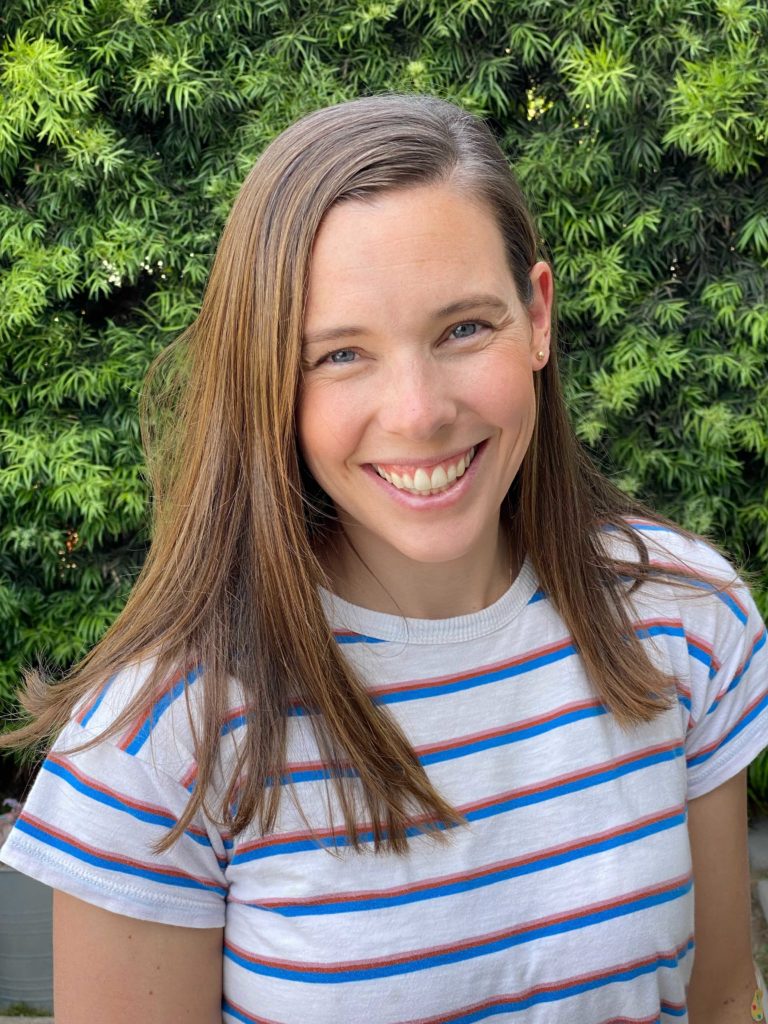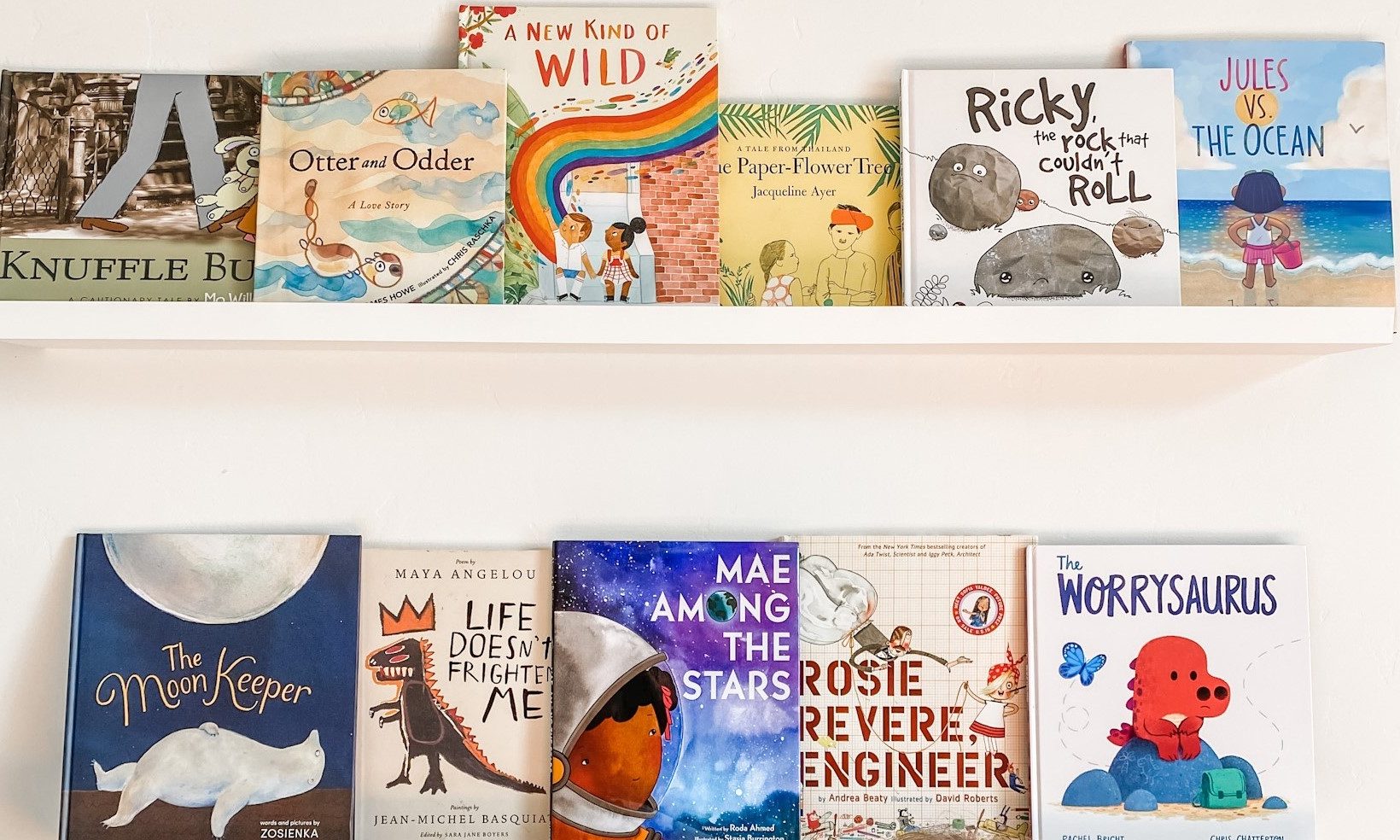By Katherine DeVries | @thepaperdart
Helping your child find their groove at the start of the school year is no easy feat, especially if school is a new environment. And while it’s important to send kids off to class with a well-fitting pair of shoes and a backpack stocked with school supplies, it’s even more important to make sure they’re walking through the door with the emotional skills they need to bounce back after that inevitable first setback (be it a not-so-nice table partner, or realizing you purchased all the wrong notebooks…). So, to help guide you and your littles through the transition, I’ve compiled a list of some of my favorite picture books which touch on the theme of emotional resilience and learning how to thrive in school, even when the going gets tough.
1. The Dot by Peter H. Reynolds
Every kid is a beginner at something. Whether it be soccer, or art, or tying their shoes. And while it’s easy for us adults to have perspective on our kids’ various skills (or lack thereof), it’s sometimes much harder for the kids themselves to face their growing pains head-on, and just begin.
Enter, The Dot: a lovely little book about a boy who is as sure that he can’t paint, as his teacher is that he could—if only he’d try. While there’s great value in everything from this story’s fantastic illustrations, to the protagonist’s heart-warming journey from obstinate art student to the maker of masterpieces, my favorite scene occurs when the young hero passes his newfound knowledge on to the next generation of stubborn scholars, and inspires another, like-minded youth that he, too, can.
2. Rosie Revere, Engineer by Andrea Beaty
When our kids go out into the world, or into the classroom, they rely on the reactions of others (both adults, and kids) as a means of making sense of their world, and their place in it. And while learning from the feedback they receive can be important (we can’t be eating our boogers in public, for example), we also need to teach our kids how to filter the reactions that come their way, and how to parse the criticism intended to deter them, from that which is meant to propel them forward.
Like many of our kids, Rosie, the protagonist of this incredibly important book, is a bit wacky. And perhaps throws a little too much caution to the wind. But her passion for inventing is fierce, and she throws herself into all manner of creative projects until, one day, she takes her uncle’s unwitting critique too much to heart. When her beloved Aunt Rose eventually inspires her to pick up her toolkit once more, Rosie learns that it’s actually the ability to fail, laugh, and learn from their mistakes, that makes real inventors truly great.
3. A New Kind of Wild by Zara Gonzalez Hoang
A few years ago, my family was preparing to move, and a dear teacher friend of mine warned me that it might be a bit challenging for my kids. “Their house is their entire world,” she said. “To a kid, switching homes can be like switching planets—and the growing pains will correlate.” She was right. And while we have all grown to love the new home, the adjustment phase was difficult to say the least.
A New Kind of Wild is a wonderful book for kids who are moving in any sense of the word—be it homes, schools, or even classrooms. In the book, the protagonist, Ren, has a pretty great thing going on, living on the edge of the magic-inspiring rainforest of El Yunque, Puerto Rico. But when he unexpectedly moves to the concrete jungle of the city, he feels like his life has permanently lost its luster. Fortunately, Ren finds a friendly neighbor named Ava who shows him that magic can be found anywhere, as long as you know how to look for it. This is one of our absolute favorite books—both for the story, and the incredible illustrations—and serves as such a fantastic reminder that our situation is what we make it, and perspective is everything.
4. Jules vs. The Ocean by Jessie Sima
The comparison game is fierce in elementary school. (And, if we’re being totally honest, in adulthood as well). Kids are obsessed with watching, learning from, and comparing themselves to others. And while these tendencies are necessary in some ways (this is how I learned to do everything from card tricks, to kickball after all), they can also make kids feel like they can’t, or won’t, ever really measure up.
In Jules vs. The Ocean, Jules can’t seem to figure out why her mediocre sandcastle keeps getting pummeled by the sea, while the rest of the kids on the beach have somehow managed to create semi-permanent sand replicas of Versailles. Time and time again, she piles sand up, only to watch, despairingly, as it gets washed away. When, at last, Jules’s beloved bucket gets claimed by the sea, she’s finally reached her wit’s end, and is ready to quit. However, when her older, and wiser, sister comes to her aid, Jules learns that sometimes the process, and the fun you have doing it, is more important than what happens (or doesn’t happen) in the end.
5. The Moon Keeper by Zosienka
(Spoiler alert: this is my favorite one.) In this charming book, a somewhat new-to-the-world bear is awarded the title of “Moon Keeper” by the rest of the forest animals, and is tasked with keeping an eye on the moon. During his month-long watch, bear is alarmed to find that the moon is, *gasp,* shrinking, and no one can seem to help him make it stop.
At the end of the book, as bear stares despairingly up at an empty night sky, a feathered friend comes to comfort him. That night, bear learns an important lesson, about both the nature of the moon, and the transience of suffering. This book is quite honestly one of the most profound children’s books I’ve ever read, and a fantastic conversation-starter for parents of kids who feel like they’re in the midst of something that will “never end.”

6. The Worrysaurus by Rachel Bright
Anxiety can be truly crippling for kids. As a teacher, I’ve seen many a capable child fail a quiz or two purely because they were so up in their own heads. But what matters much more than the grades are the various ways in which worrying too much can prevent kids from really showing up in their own lives—in terms of taking risks, making friends, and trying something new.
In The Worrysaurus, the little worrysaurus sets off for a day of adventuring, only to be sidetracked by the bazillion “what-ifs” floating through his head. As the day wears on, a potentially perfect adventure becomes so shrouded in anxiety, that the worrysaurus begins to miss out on a lot of the beauty, and adventure, that’s waiting just ahead. Thankfully, worrysaurus has a pretty wise mom who reminds him to focus on the here and now, as worrying too much about what could happen only takes away from what already is. This book both normalizes anxiety, and gives kids (and parents) the skills to cope with it. And boy, if that isn’t something we all need this school year.
7. Mae Among The Stars by Roda Ahmed
People will tell our kids they can’t do things. Our kids will even tell themselves they can’t do things. And while my daughter might never be a track star (my family’s DNA tends to favor things like science olympiad and Pokemon club over the more athletic pursuits), she certainly shouldn’t give up just because someone tells her to.
Mae Among The Stars is the most beautiful book about a girl who rises above the limitations her teachers, and her peers, put upon her, and achieves what so many people considered to be “impossible.” This gorgeously illustrated story was inspired by Mae Jemison’s own childhood, and the roadblocks she overcame before becoming the first African American woman to go to space. To be totally honest, I loathe books about space (I’m a bit of a Worrysaurus about the great unknown…), but this one is an absolute favorite of mine, and a bookshelf and classroom must-have.
8. Nightsong by Ari Berk
In my mind, resilience and risk-taking go hand-in-hand. If kids never push the boundaries of what feels “safe,” or “comfortable,” they’ll never be faced with opportunities to struggle and learn. And I firmly believe that it’s in the struggle, and the foray into the unknown, that they (and we, as their parents) become the best versions of ourselves.
Nightsong is a treasure of a book about a little bat named Chiro, whose mother sends him out on his own one night, with only his “good sense” to guide him. Throughout the book, Chiro learns about the world around him, and pushes the boundaries of his mother’s instructions, while holding tight to her wisdom all the same. I love this book, not only because it teaches kids that just because something is scary at first, that doesn’t mean it won’t be worth it in the end, but also because it teaches parents the importance of letting go.
9. Otter and Odder by James Howe
All kids have their differences. I, for example, refused to wear matching socks for the majority of my childhood. And while some kids are confident enough to throw caution to the wind and just “do their thing,” most are a little more susceptible to the pressure to conform (whether it be perceived, or real). While I hope my kids find connection and acceptance in school, I also hope they have the confidence and wherewithal to filter the feedback they receive from others, and always stay true to themselves—because it’s often in being the most authentic version of ourselves that we find the greatest happiness.
In Otter and Odder, the river animals have a somewhat narrow-minded set of rules about which animals are allowed to fall in love, and which are supposed to eat each other instead. So, when Otter falls in love with Gurgle (a fish), the town is abuzz, and not in a good way. In an attempt to appease their freshwater friends, Otter and Gurgle part ways. While their uncoupling allows them to find “acceptance” in the wider community, they also find that they have never felt more alone. Thankfully, Beaver, who is “known for his wisdom,” eventually comes along to set the couple straight, and everyone—including the nosy neighbors—live happily every after.
10. Knuffle Bunny, Knuffle Bunny Too, and Knuffle Bunny Free by Mo Willems
Let’s not sugar coat it: Your kid is going to lose something this year. It might be a beloved stuffed animal, or a favorite pencil, or the pair of shoes they begged for all summer. It might be a soccer game, or a spelling bee, or the daily race to the lunch line. And it might even be a friend, or an old classroom, or a last-year teacher that they loved. Getting over a loss of any kind is difficult, and bouncing back from disappointment is not necessarily a skill our kids are born with. But we can certainly teach it.
Throughout the Knuffle Bunny series, the protagonist, Trixie, experiences some close calls with her beloved bunny. In the first installation, dad abandons the stuffed companion at the Laundromat, while in the second book, Kuffle Bunny ends up confiscated by a teacher (for good reason, of course). But it’s the last book that hits a real home run in the sentimentality department, as Trixie grieves and learns to let go of, a bunny she assumes she’ll never see again. And even though what once was lost, is eventually (and miraculously) found again at the end, Trixie realizes that she might not actually need the things she always thought she did—at least, not as much as someone else does.


Katherine DeVries | @thepaperdart
Katherine is a stay-at-home-mom to three kids. She and her husband are originally from the Midwest but now reside in sunny, Southern California. Before taking time off last year, she spent 10 years teaching middle school English in public and charter schools throughout the Los Angeles area. She has a passion for literature (of both the children and adult varieties) which she shares on her personal blog, The Paper Dart.



Leave a Reply